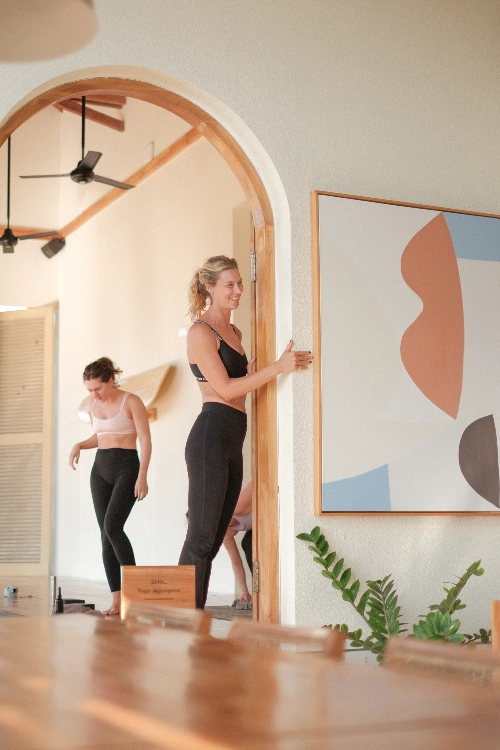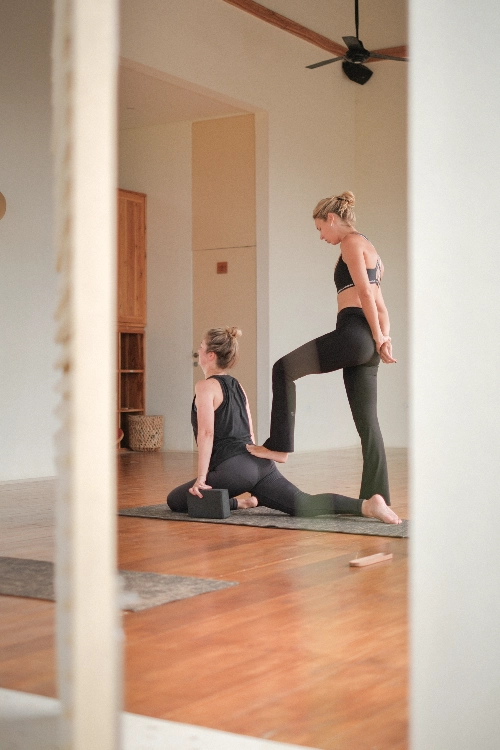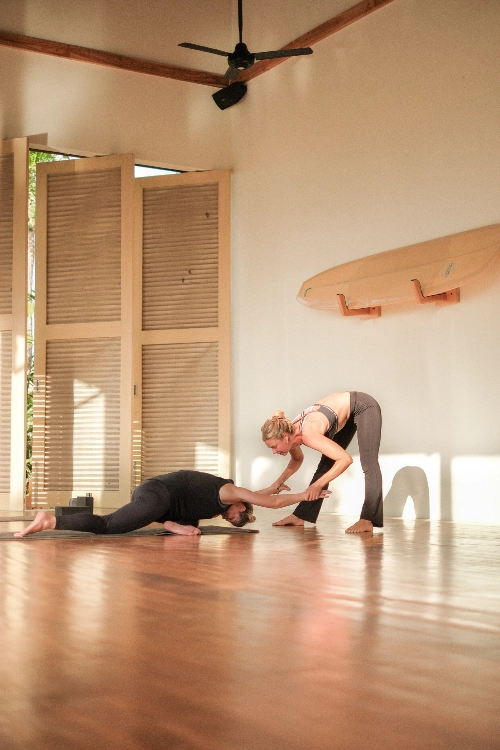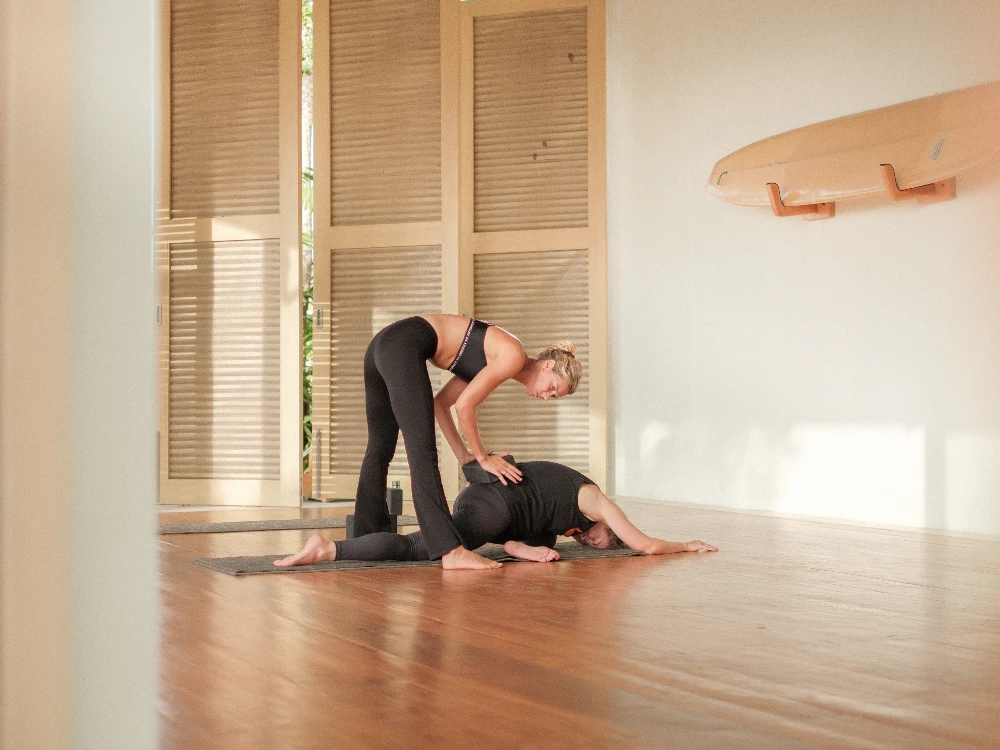There are plenty of memorable pairings in the world.
Longboarding and Lombok. Ice-cold drinks on a hot day. Kermit and Miss Piggy.
However, we’re sure most surfers would agree that yoga and surfing is also up there. This combination has both a positive effect on our overall wellbeing and life in general. It’s almost like they were made for each other.
But can practising yoga improve your surfing? Do yoga poses actually make popping up easier? Can landlocked surfers keep their skills sharp through online yoga classes?
After quizzing yoga practitioners and past Xanadu guests, we’ve come to some pretty strong conclusions about how yoga can help you become a better surfer.



The history of yoga for surfers
Yoga for surfers isn’t a new concept.
The pairing of yoga classes or a personal yoga practice with surfing has been around for decades. Yoga’s origins date back to ancient India, while the roots of surfing stem from Polynesian culture. Both practices have a long history of promoting physical and mental wellness.
In the 1970s, surfers in California began integrating yoga into their routines to improve their surfing performance. Yoga poses were found to increase flexibility, balance and strength — all essential skills for riding waves.
Perhaps the most famous surfer to ever grace a yoga mat is the Hawaiian surfer, raconteur and waterman, Gerry Lopez.
Well into his mid 70s at the time of writing, Lopez still has the lithe body and smooth, powerful surfing style that he is known for. His dedication to practice yoga well into his later years is admirable, and he credits it with keeping him in shape and allowing him to continue surfing at a high level.
He even recently began learning how to foil. Seriously, how many septuagenarian’s do you know who are taking up a challenging and physically demanding watersport like foiling?
7 ways yoga helps you surf better
Clearly, yoga for surfers is a fantastic idea. Especially so if you want to cross-step into your golden years, become a more confident surfer or simply improve your overall quality of life.
To understand why yoga for surfers is so beneficial, let’s take a closer look at some of the ways it makes popping up, toes on the nose and cutbacks just that little bit easier.
1. Yoga makes learning to surf less intimidating
Regular practice with a detail-oriented yoga teacher doesn’t just help on a physical level.
It also helps you develop a sense of calm and focus that can be applied to any challenging activity, such as learning to surf.
Having, or at least developing, a solid mind-body connection is critical to surfing. Once you’ve pushed, stretched and flexed your body in a variety of yoga poses, you’ll build confidence in your ability to sweep that back leg, pop up and catch your first waves.
2. It teaches you to become comfortable with discomfort
The physiological effect of holding a yoga post for an extended period of time, whether it be downward facing dog, pigeon pose or plank pose, is similar to the struggle we face during uncomfortable surf sessions.
Balancing on a floating plank of foam, getting tossed around by waves and paddling out for hours can all be physically demanding and mentally taxing.
Yoga prepares you to handle various ocean challenges with grace and ease.
By attending yoga classes on a regular basis, you’ll soon become more comfortable with being uncomfortable. This mindset can help you push through the tough moments in surfing and ultimately improve your performance.
3. There are yoga poses that mimic surfing movements
No joke, it really feels like yoga and surfing were destined to find each other. The fact that many yoga positions resemble movements we make in surfing is uncanny.
For example, the cobra pose mimics the early stages of a pop-up, while the malasana pose helps build strong leg muscles needed for balancing on a board. Likewise, the warrior II pose is great for developing core strength. It also looks somewhat similar to a surfer’s stance.
Learn more about our favourite exercises when it comes to fitness and yoga for surfers.
4. You can get started with very little gear
Another thing yoga and surfing have in common is that you don’t need a lot of equipment to get started.
Like surfing in the tropics, you’re only required to use a few different items. A yoga mat for one. Maybe a yoga towel too. You can even use a block or band for help with stretching.
Whatever your preference, the core gear requirements don’t really change.
This is one of the most underrated benefits of combining a yoga and surf holiday, given that the amount of gear you have to travel with is reduced.
5. Regular yoga practice helps with injury prevention
City surfers or landlocked surfers naturally don’t get the same amount of practice as their coastal counterparts.
This can be detrimental when it comes time to paddle out, catch a wave and pop up.
If you haven’t surfed in a while, you may experience muscle soreness or even potential injury. Yoga for surfers prevents injuries by keeping you limber and building the strength and endurance needed to withstand hours in the water.
Of course, our surf guiding experts will take you through a proper warm-up before each surf session, but nothing beats a yoga for surfers routine to keep you in tip-top shape.
6. Both surfing and yoga bring you into the present moment
Becoming the best surfer you can be requires you to build your mindfulness skills on land.
You need to relax, stretch and be conscious of your overall flexibility, but you also need to understand that yoga is a form of meditation.
Seeing yoga as a means to develop a meditative practice can help you stay in the present moment.
Without getting too zen, this just means that you’ll be completely ‘in the zone’ whenever paddling into and riding waves.
Most people see surfing as a sort of moving meditation, so we’re sure everyone from beginners to more experienced surfers will be right at home with this.
7. Yoga helps with breath control and endurance
Last but not least, yoga helps with the most important aspect of surfing – breathing.
A relaxed breathing pattern is vital for maintaining endurance in the water.
Yoga teaches you how to control your breath and use it efficiently, which is essential for long surf sessions when you need to conserve energy.
In addition, yoga poses that require holding or regulating your breath can also help build lung capacity over time.
This will ensure that when faced with a scary wipeout or rolling wall of water coming straight for you, you can relax, breathe and focus on staying calm.
This is the key to confidence on a surfboard, and any pro will tell you that besides strong core muscles, a good sense of balance and ocean intuition, breath control is what ultimately separates the best from the rest.
FAQ about yoga and surfing
Why are yoga and surfing a good combo?
Both arts share a lot of similarities, such as connecting the mind and body, building strength and flexibility and practising presence. Yoga also helps with injury prevention and improving breath control, which are crucial for surfing.
Should landlocked or city surfers consider yoga for surfing?
Definitely! It sucks to be away from the ocean, but you shouldn’t let the lack of an oceanic horizon dull your surf spirit. Make your current life situation work for you and stretch or begin a yoga routine at home.
Is yoga, mobility or pilates better for surfing?
It’s hard to split the three since they’re all so different, but yoga is for sure the most accessible. Unlike pilates, you don’t need to use specific apparatuses. Yoga also goes beyond just physical movements by incorporating breathing and mindfulness practices that are beneficial for surfing.
Final thoughts
From pain relief to the strengthening of muscles and the mind-body connection, yoga can help you become a confident, self-assured surfer. Poses such as the cobra pose, upward facing dog and warrior II are well-suited to pop ups, and when practised regularly, they’ll help you breathe, feel great and ultimately enjoy your surf sessions even more.




